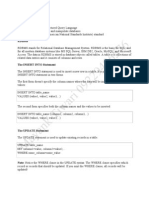0% found this document useful (0 votes)
19 views37 pagesCreate Database School
The document provides a comprehensive overview of SQL commands and syntax for database management, including creating databases, tables, and constraints such as primary keys, foreign keys, and unique constraints. It also covers data manipulation commands like SELECT, INSERT, UPDATE, and DELETE, as well as various operators and functions used in SQL queries. Additionally, it explains concepts like joins, aggregate functions, and the use of clauses such as GROUP BY and HAVING.
Uploaded by
syonasrivastava123Copyright
© © All Rights Reserved
We take content rights seriously. If you suspect this is your content, claim it here.
Available Formats
Download as PDF, TXT or read online on Scribd
0% found this document useful (0 votes)
19 views37 pagesCreate Database School
The document provides a comprehensive overview of SQL commands and syntax for database management, including creating databases, tables, and constraints such as primary keys, foreign keys, and unique constraints. It also covers data manipulation commands like SELECT, INSERT, UPDATE, and DELETE, as well as various operators and functions used in SQL queries. Additionally, it explains concepts like joins, aggregate functions, and the use of clauses such as GROUP BY and HAVING.
Uploaded by
syonasrivastava123Copyright
© © All Rights Reserved
We take content rights seriously. If you suspect this is your content, claim it here.
Available Formats
Download as PDF, TXT or read online on Scribd
/ 37
























































































